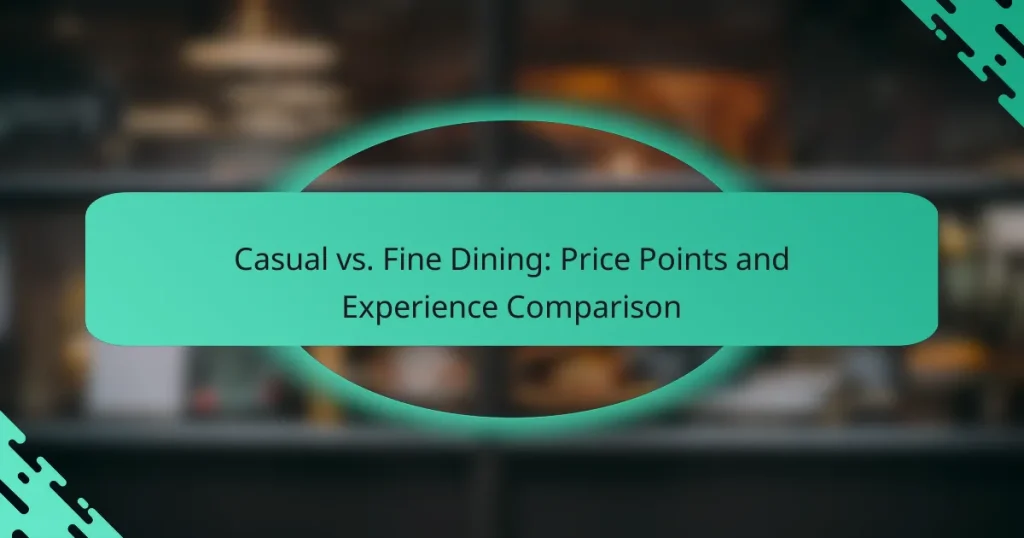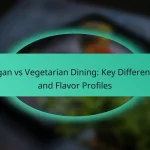In the vibrant culinary landscape of Los Angeles, casual dining offers meals ranging from $10 to $30, appealing to a wide array of tastes and budgets. In contrast, fine dining experiences start at around $50 per person and can soar into the hundreds, emphasizing not just exceptional cuisine but also an elevated ambiance and attentive service. The distinction between these dining styles lies in their atmosphere, service quality, and overall experience, catering to different occasions and preferences.

What are the price points for casual dining in Los Angeles?
In Los Angeles, casual dining typically ranges from around $10 to $30 per meal per person. This price point reflects a variety of options, including fast-casual establishments and sit-down restaurants, catering to diverse tastes and budgets.
Average meal cost
The average cost of a meal in a casual dining setting in Los Angeles is generally between $15 and $25. This includes a main dish and possibly a drink, with prices varying based on the restaurant’s location and menu offerings.
For families or groups, sharing appetizers or opting for lunch specials can help keep costs lower while still enjoying a full dining experience.
Typical price range
Casual dining prices in Los Angeles usually fall within the $10 to $30 range per person, depending on the type of cuisine and the restaurant’s ambiance. Lower-end options might include fast-casual chains, while mid-range establishments often feature a more extensive menu and better service.
It’s common to find promotions or happy hour deals that can further reduce costs, making it easier to enjoy a meal out without overspending.
Popular casual dining chains
Some well-known casual dining chains in Los Angeles include The Cheesecake Factory, Olive Garden, and BJ’s Restaurant & Brewhouse. These establishments offer a diverse menu and a comfortable atmosphere, appealing to a wide range of diners.
Additionally, local favorites like In-N-Out Burger and Chipotle provide quick, affordable options that are popular among residents and visitors alike.

What are the price points for fine dining in Los Angeles?
In Los Angeles, fine dining typically involves higher price points, often starting from around $50 per person and can exceed several hundred dollars for a multi-course experience. The cost reflects not only the quality of the food but also the overall dining experience, including ambiance and service.
Average meal cost
The average cost of a fine dining meal in Los Angeles generally falls between $75 and $150 per person. This includes appetizers, main courses, and possibly a dessert, along with non-alcoholic beverages. Wine pairings or cocktails can significantly increase the total bill.
Typical price range
Fine dining establishments in Los Angeles usually have a price range that starts around $50 for a basic entrée and can go up to $300 or more for a complete tasting menu at high-end restaurants. Many places offer prix fixe options that provide a set number of courses for a fixed price, which can be a more economical choice for experiencing multiple dishes.
Notable fine dining restaurants
Los Angeles is home to several acclaimed fine dining restaurants, including n/naka, which specializes in kaiseki cuisine, and Bestia, known for its Italian fare. Other noteworthy mentions include Spago, offering contemporary Californian dishes, and Urasawa, which provides an exclusive sushi experience. Reservations are often recommended due to high demand.

How do casual and fine dining experiences differ?
Casual dining and fine dining experiences vary significantly in terms of service, ambiance, and menu offerings. Casual dining typically emphasizes a relaxed atmosphere and affordability, while fine dining focuses on high-quality service, exquisite decor, and gourmet cuisine, often at a higher price point.
Service quality comparison
In casual dining, service is generally friendly and efficient, but it may lack the formal training found in fine dining establishments. Casual restaurants often have a more laid-back approach, where servers may not be as knowledgeable about the menu or wine pairings.
Fine dining restaurants prioritize exceptional service, with staff trained to provide a personalized experience. This includes detailed menu knowledge, attentive service, and often a higher server-to-guest ratio, ensuring that diners feel well cared for throughout their meal.
Ambiance and decor
Casual dining venues usually feature simple decor and a relaxed atmosphere, making them suitable for families and groups. The focus is on comfort rather than elegance, with functional furnishings and casual table settings.
In contrast, fine dining establishments invest heavily in ambiance, featuring upscale decor, soft lighting, and carefully curated table settings. The atmosphere is designed to create a luxurious experience, often incorporating elements like live music or art to enhance the dining experience.
Menu variety
Casual dining menus typically offer a wide range of familiar dishes, from burgers to pasta, catering to diverse tastes at moderate prices. These menus often include comfort food and quick-service options, making them accessible to a broad audience.
Fine dining menus focus on gourmet cuisine, often featuring seasonal ingredients and unique flavor combinations. These menus may change frequently and include tasting menus or multi-course options, allowing chefs to showcase their culinary skills. Prices can vary widely, often starting in the higher range, reflecting the quality and creativity of the dishes offered.

What factors influence dining choices in Los Angeles?
Dining choices in Los Angeles are influenced by a variety of factors, including the occasion, customer preferences, and the location of the restaurant. Understanding these elements can help diners select the right dining experience, whether they are looking for casual or fine dining options.
Occasions and events
Different occasions call for different dining experiences. Casual dining is often preferred for everyday meals, family gatherings, or informal outings, while fine dining is typically reserved for special events like anniversaries, business meetings, or celebrations.
For example, a birthday dinner might be celebrated at a fine dining restaurant to create a memorable experience, whereas a casual lunch with friends could take place at a local café or bistro. The choice of venue often reflects the significance of the occasion.
Customer preferences
Individual tastes and preferences play a crucial role in dining choices. Some customers may prioritize a relaxed atmosphere and comfort food, favoring casual dining establishments, while others might seek gourmet dishes and an upscale ambiance found in fine dining.
Additionally, dietary restrictions and culinary trends can influence preferences. For instance, a growing interest in plant-based cuisine may lead diners to choose casual spots that offer innovative vegetarian options over traditional fine dining.
Location and accessibility
The location of a restaurant significantly impacts dining choices in Los Angeles. Areas with high foot traffic or proximity to popular attractions often feature more casual dining options, making them easily accessible for quick meals.
In contrast, fine dining establishments may be located in upscale neighborhoods or near cultural landmarks, attracting diners willing to travel for a premium experience. Consideration of parking availability and public transport options can also affect the decision on where to dine.

How do casual and fine dining compare in terms of customer experience?
Casual dining and fine dining offer distinct customer experiences, primarily influenced by atmosphere, service, and overall expectations. Casual dining tends to be more relaxed and informal, while fine dining emphasizes elegance and meticulous service.
Dining atmosphere
The atmosphere in casual dining is typically laid-back, featuring comfortable seating and a welcoming vibe. Restaurants in this category often have vibrant decor and a lively ambiance, making them suitable for families and groups.
In contrast, fine dining establishments focus on creating an upscale environment, often characterized by elegant furnishings, subdued lighting, and a quieter atmosphere. This setting is designed to enhance the dining experience, encouraging guests to savor their meals in a refined space.
Reservation policies
Casual dining restaurants usually do not require reservations, allowing for spontaneous visits. Customers can often walk in without waiting, making it convenient for those looking for a quick meal.
Fine dining venues, however, typically encourage or require reservations to manage seating and provide personalized service. It’s advisable to book a table well in advance, especially for popular restaurants or during peak dining times.
Dining duration
Dining duration in casual restaurants is generally shorter, with meals lasting around one to two hours. This quick turnover allows for a steady flow of customers, catering to those with busy schedules.
On the other hand, fine dining experiences are designed to be leisurely, often lasting two to three hours or more. This extended duration allows guests to enjoy multiple courses and engage in conversation, making the meal a significant event rather than just a quick bite.

What are the emerging trends in dining experiences?
Emerging trends in dining experiences focus on personalization, sustainability, and technology integration. Diners increasingly seek unique experiences that reflect their values and preferences, leading to innovative approaches in both casual and fine dining settings.
Personalization in Dining
Personalization in dining involves tailoring the menu and service to individual preferences. Restaurants are utilizing data analytics to understand customer tastes, allowing them to offer customized dishes and experiences. For example, some establishments now provide options for dietary restrictions or preferences, enhancing customer satisfaction.
To implement personalization effectively, restaurants can gather feedback through surveys or loyalty programs. This approach not only improves the dining experience but also fosters customer loyalty, as diners feel valued and understood.
Sustainability Practices
Sustainability in dining emphasizes environmentally friendly practices, such as sourcing local ingredients and reducing food waste. Many restaurants are adopting farm-to-table models, which support local farmers and provide fresher options for customers. This trend resonates particularly well with environmentally conscious diners.
Restaurants can enhance their sustainability efforts by implementing composting programs and minimizing single-use plastics. These practices not only appeal to eco-minded consumers but can also lead to cost savings in the long run.
Technology Integration
Technology integration is transforming the dining experience through innovations like online reservations, digital menus, and contactless payments. These advancements streamline the dining process and enhance convenience for customers. For instance, QR codes are now commonly used for menu access, allowing diners to view options on their smartphones.
To stay competitive, restaurants should invest in user-friendly technology that enhances the customer experience. However, it’s crucial to balance tech use with personal interaction to maintain a warm and inviting atmosphere.


